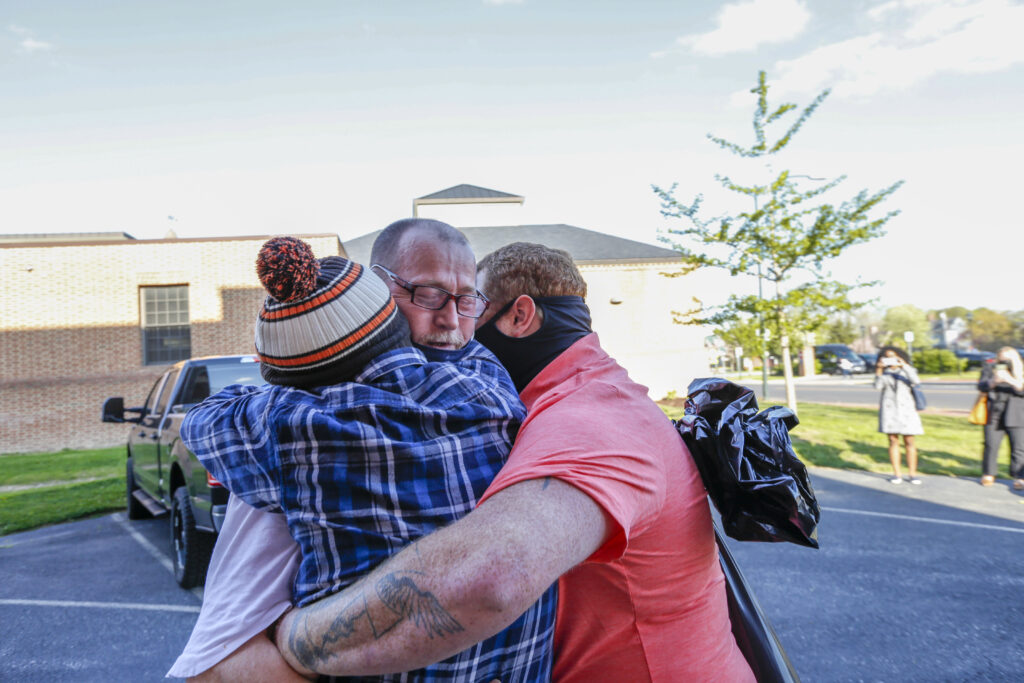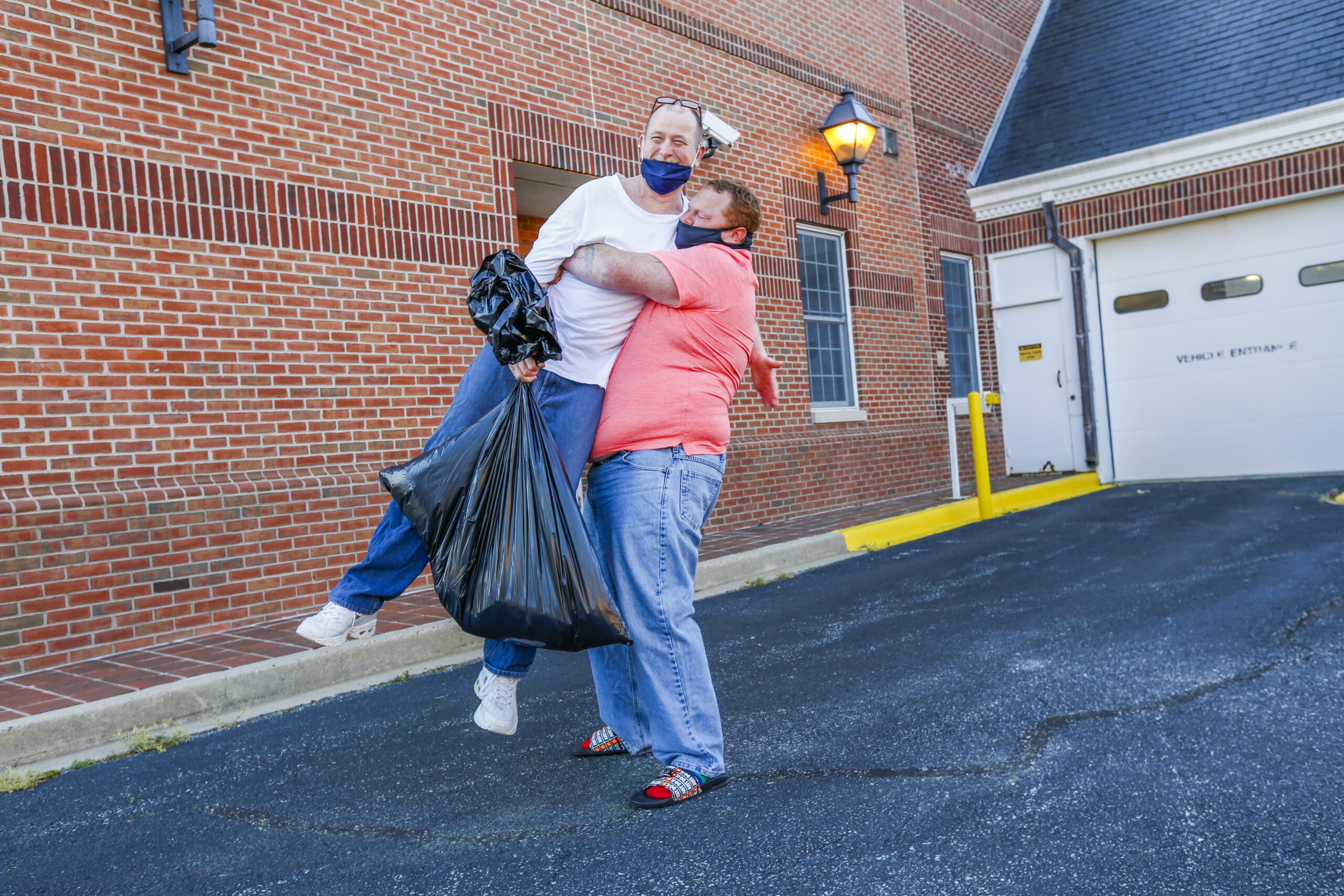Jonathan Smith Walks Free After 21 Years of Wrongful Imprisonment
04.21.21 By Innocence Staff
(April 21, 2021 – Easton, Maryland) Today Jonathan Smith, Sr. was freed after nearly 21 years in prison for a murder he did not commit. Mr. Smith entered a conditional Alford plea, under which he expressly maintains his innocence. The terms of the plea allow Mr. Smith to appeal earlier decisions in his case, including Mr. Smith’s position that all charges against him must be dismissed.
Just under a year ago, the Maryland Court of Appeals unanimously reversed the 2001 murder convictions of Mr. Smith and his co-defendant David Faulkner and granted both men Writs of Actual Innocence. The Court’s decision was based on new palm print evidence found at the crime scene identifying an alternative suspect, and exculpatory evidence that the prosecution improperly withheld from the defense regarding the reliability of informant testimony. Despite this overwhelming evidence of innocence, Mr. Smith — until today — was facing a retrial in the Circuit Court for Talbot County.
The conditional Alford plea allows Mr. Smith to maintain his innocence and preserves his right to appeal his conviction and judgment. Mr. Smith’s decision to enter into this plea is based upon his contention that his ability to present a full defense at any retrial has been permanently prejudiced as a result of the State’s intentional, willful and/or reckless misconduct and that, as a result, he can no longer obtain a fair trial in this case. On the basis of that prejudice, Mr. Smith maintains that his due process rights under the Maryland and United States’ Constitutions and protection against double jeopardy have been violated.
“Today, after more than two decades fighting for his innocence, Mr. Smith will reunite with his family and friends,” said Susan Friedman, Mr. Smith’s Innocence Project attorney. “Mr. Smith continues to steadfastly maintain his innocence and is hopeful that he will receive the justice he deserves.”
“A year ago, the Court of Appeals unanimously recognized the significance of the innocence evidence in Mr. Smith’s case,” said Don Salzman, Mr. Smith’s attorney with Skadden, Arps, Slate, Meagher and Flom LLP. “ We will continue to fight to make sure that Mr. Smith is fully vindicated.”
Case History
Mr. Smith and Mr. Faulkner were convicted of the 1987 murder of 64-year-old Adeline Wilford in 2001 and sentenced to life in prison. A third co-defendant, Ray Earl Andrews, Sr., who was 16 at the time of the crime, was sentenced to 10 years for burglary in exchange for testifying against the two older men. There was no physical evidence linking the three men to the crime.
The case had gone cold for 13 years until a witness falsely claimed to have seen the three men fleeing from the crime. The witness, Beverly Haddaway, alleged that she saw the three young men walk out of a cornfield approximately a few miles away from the Wilford home on the afternoon of the murder, and that Mr. Smith had blood on his shirt. On March 1, 2001, a jury convicted Mr. Smith of felony murder and daytime housebreaking and a month later, the court sentenced him to life in prison.
In 2011 and 2012, lawyers from the Innocence Project and the Mid-Atlantic Innocence Project filed Public Information Act requests. For the first time, the Maryland State Police disclosed police recordings of conversations between Ms. Haddaway and Maryland State Police Corporal John Bollinger. These recordings revealed that Ms. Haddaway had demanded that the state dismiss unrelated drug charges against her grandson in exchange for her testimony against Mr. Smith and Mr. Faulkner. The recordings also show that the state refused to place that deal in writing to prevent Ms. Haddaway from being cross-examined on the issue. The state, in fact, dismissed the charges three days before Mr. Andrews’s trial was scheduled to begin.

Jonathan Smith is reunited with his two sons on April 21, 2021.
(Image: Eric Kayne/AP Images for the Innocence Project)
In 2013, Mr. Smith filed motions to reopen their post-conviction proceedings based on these recordings and filed a motion for post-conviction latent print comparison for previously unidentified palm prints on the sill of an open window and inside Ms. Wilford’s home. In March 2014, the state’s attorney acknowledged that the prints matched an offender in the database, but refused to disclose his identity for a year. When the identity was finally revealed in 2015, lawyers discovered that the prints matched those of Ty Anthony Brooks, who was incarcerated at the time and had previously served prison time for a similar burglary in which he was alleged to have assaulted another elderly woman within months of Ms. Wilford’s murder.
Evidentiary hearings were held on this new evidence in 2016 and 2018 in the Circuit Court for Talbot County. On April 27, 2020, in a unanimous opinion by the Court of Appeals, Mr. Smith’s and Mr. Faulkner’s petitions for Writs of Actual Innocence were granted.
The State Suppressed Key Evidence
More than a decade after Mr. Smith’s conviction, it was learned that prosecutors in this case hid a wealth of exculpatory evidence from the defense. The most crucial pieces were the tape recordings of the State’s informant witness Ms. Haddaway and lead investigator, Maryland State Police Corporal Bollinger, making a deal to dismiss the drug charges against Ms. Haddaway’s grandson in exchange for her testimony against Mr. Smith and his co-defendant. This exchange, in addition to a host of other inculpatory tape recordings, would have entirely discredited their testimony at trial. The recordings demonstrated that the State’s misconduct tainted every trial witness it presented against Mr. Smith during his 2001 trial, and could have effectively altered the verdict.
In addition to the tapes, foreign DNA had been recovered and tested from the victim’s fingernails. The State determined that Mr. Smith and his co-defendants were excluded as matches to that DNA. In November 2000, a Maryland State Police DNA analyst advised prosecutors that, in addition to the victim’s DNA profile, there was a partial foreign DNA profile recovered from the victim’s fingernails that did not match Mr. Smith or his co-defendant. Yet, in a subsequent letter to defense counsel, two months before Mr. Smith’s trial, the prosecutor lied about the results of the DNA testing on the fingernail evidence, stating, “I have been advised that the fingernail clippings, not surprisingly, are showing only the victim’s DNA.” This lie was further exploited in the State’s closing arguments at trial, explaining to the jury that there was no DNA evidence in this case.
Mr. Smith is represented by Susan Friedman and Barry Scheck of the Innocence Project, and Donald Salzman, Nathan P. Wacker, Andrew Hanson, William A. Bejan, Barri T. Dean, Ariana M. Taylor and Lucy Dicks-Mireaux of Skadden, Arps, Slate, Meagher and Flom LLP.
Leave a Reply
Thank you for visiting us. You can learn more about how we consider cases here. Please avoid sharing any personal information in the comments below and join us in making this a hate-speech free and safe space for everyone.
September 28, 2021 at 3:22 pm
September 7, 2021 at 1:35 pm
Why don’t the prosecutors get prosecuted and imprisoned for the same length of time that they took from these innocent men. Then maybe prosecutors would stop pulling this crap.

Sue the crap out o the state!!!!